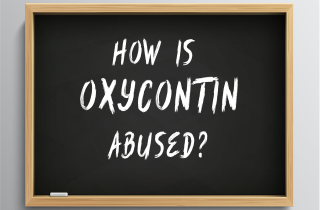When you look at labels for prescription OxyContin, the manufacturer has been regulated by the FDA to print warnings. They warn against taking OxyContin in certain ways. OxyContin shouldn’t be; cut, broken, chewed, crushed, or dissolved. The warning label also advises that you never take more OxyContin than prescribed. There is a reason for this.
The more you abuse OxyContin and start getting high with OxyContin, the you damage your body and interrupt the chemical communication in the brain. Continue reading here for more on OxyContin abuse and then leave us your questions about OxyContin or treatments for OxyContin addiction in the comments section below.
Can OxyContin be abused?
Yes, OxyContin can be abused. In fact, any time you take OxyContin to get high, you are abusing OxyContin. However, opioids like OxyContin have the potential of becoming habit forming. In addition to physical dependence, OxyContin can provoke psychological dependence. In fact, many who wish to avoid withdrawal continue to take OxyContin regardless of the harm it causes them.
Still, OxyContin is a common drug to abuse because of how easy it is get. While there are regulations in place to prevent illegal sales of prescription drugs, people can get a large supply of OxyContin from the doctor. You can also get your hands on Oxy’s by searching the internet or looking through the black market in order to maintain a supply.
How OxyContin is abused
OxyContin is commonly abused when you alter the way you take the medication. When you take OxyContin orally, you activate the controlled release properties of the medication. This way, oxycodone addresses pain without the added presence of side effects or an induced euphoric high. Ways to abuse OxyContin may include snorting or injecting it into the bloodstream. OxyContin ais also mixed with other substances. It’s common to for people to also use alcohol, heroin, or cocaine in combination with OxyContin, drugs that may heighten the effects of an OxyContin high.
OxyContin abuse side effects
When you change the way you take OxyContin, you have a higher likelihood of experiencing adverse and negative side effects which are normally controlled by taking it orally. The reason this occurs is because you have uncontrolled amounts of oxycodone in the body. And depending on how you’re abusing OxyContin you can open yourself up to disease and overdose. Possible OxyContin abuse side effects include:
- changes in mood regulators
- coma
- constipation
- damage to the liver
- euphoria
- fatigue
- heart attack
- irregular breathing
- overdose
- respiratory depression
As you abuse OxyContin, you also will affect more than just your physical wellbeing. Oxycontin abuse will eventually affect you social, financial, and family relationships. The more you abuse OxyContin, the more use will impact your responsibilities and alter the course of your personal, social and work life.
Signs of OxyContin abuse
Noticing the signs of prescription drug abuse may be difficult to notice. People are good at hiding their use of medication. However, there are clear signs that can point to OxyContin abuse. These include:
- changes in normal behavior
- chewing OxyContin
- continually fatigued or distant
- getting OxyContin through illegal means
- high dependency
- increasing doses
- mixing Oxycontin with other substance
- secretive behavior
- self-medication
- snorting OxyContin
It is important to notice these signs of abuse because you don’t want to develop an addiction to the medication. There are clinical ways you can treat dependency and abuse of OxyContin. If you feel you are abusing OxyContin and is negatively affecting your life then seek help talk to someone or talk to your doctor so that they can help you change this behavior.
Oxycontin abuse questions
Do you still have questions about Oxycontin abuse? Please leave your questions here. We will try to respond to you personally and promptly.









Related Posts